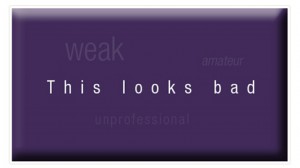 Everyone has witnessed really absurd website designs that instead of appealing, repel the visitor and force them to revert to a different page.
Everyone has witnessed really absurd website designs that instead of appealing, repel the visitor and force them to revert to a different page.
To design a good website, it is important that you have some knowledge about design conventions. Without knowing about these conventions, you might be able to create “at best” an interesting web design. There are many “would be” designers that are doing that just – “creating interesting pretty websites”.
“In any competitive marketplace, the inability to differentiate will ultimately lead to obscurity”
- Does your website reinforce your businesses’ or personal professional identity in a competitive marketplace?
- Does your website have the professional well established appearance that gives on-line customers confidence in your products or services?
- Does your website have a creative impact that will get customers and clients excited and enthusiastic about you or your company? Professional creative and quality design is an important part of your investment to ensure a positive return.
If the answers to the above questions are “no” then your website may be failing you. Your website design may be failing to adhere to some basic, yet important, important website design conventions. Some of the reasons why website designs fail are given below.
1. Lack of Balance
Balance is the basic premise when designing websites. Balance allows you to connect all elements of the website and create a proper flow. The balance might be symmetrical or asymmetrical. Symmetrical balance is based on equal weight to both sides resulting in a formal and traditional website. An asymmetrical balance means that all elements comprise of different weights leading to a unique and distinguishable website.
2. Use of Bevel and Emboss
New website designers typically use bevel and emboss a lot. This is because they believe that it will bring a nice effect to their website. However, this is not true. Bevel and emboss should not be abused, rather, these should be used sparingly so as to create an effect. Many useful tutorials exist that allow you to understand how you can transform emboss into a useful and strong technique. However, if you don’t really know how to use bevel and emboss, it is best that you avoid its usage.
3. Distracting Backgrounds
At times, people use backgrounds that are otherwise very appealing to the eye; however, when used as a background for the website, they may prove to be very distracting. Therefore, if you use a busy and heavy background, it will end up distracting the user. The user would lose the focus and the message of your website will be lost on the user. Therefore, do not use backgrounds that have a higher visual impact than your website. The users would feel that your website provides no specific information and they will leave the website very quickly.
4. Lack of Detail
Sometimes, users find a website useless because it lacks detail. If you think you have finished everything and covered every aspect of website designing, think again. You might be missing the detail of some minor things. Therefore, as a rule, always check the website design for small details.
5. White Space
White space is the space that is created between elements and is important in enhancing the readability and design flow of your website. It is also used to provide a clean look to the website making the website more readable.